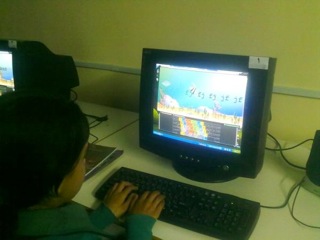Truly Integrating Technology — Nour Alkhalidy
I am a computer teacher who works at a school in a poor village where technology is kind of a big deal. Some of my students don’t have access to the Internet in their houses. Many do not even have a PC at home. At school, some teachers don’t know how to use computers. Others only utilize them in some way. It is rare to find teachers who are really integrating computers and technology into their classrooms. I am one of the few who is trying to do this. I have been working at this for eight years.
Being a teacher who is trying to integrate technology in such a context has been a little bit challenging for me. Still, although I have had some discouraging moments, my mission has been and is to create a rich environment for my students by introducing new technologies into my classroom – technologies that actively engage and motivate learners while helping me successfully deliver content.
Before planning to integrate a new technology I always consider two issues: my students’ weak basic computer skills and the school’s limited Internet access. Given these parameters, I always look for simple tools that can be used offline. As I design my lesson, I think about how a simple tool can be used to enhance clear curriculum goal and try to incorporate a strategy (often a cooperative strategy) related to such a goal. Then I design activities, making sure each separate group within my class has a task or problem to solve. I also think through how much time a task will take, what roles each student in each group will have, what instructions to give, and what the final output will be.
Personally, If the technology tool I have chosen fulfills subject content goals, improves computer, thinking, and collaboration skills, engages and motivates students, and more importantly convinces me that I cannot proceed without it, then for me I have successfully integrated technology in my classroom.
I usually prepare my lessons using Powerpoint — the old tool that will never die — to explain tasks and instructions. Sometimes I use it as a learning tool to design a virtual tour or micro-lesson.
I also use Microsoft’s FrontPage to design webquests, online scavenger hunts or 5Eonline research modules. Multi-media tools, mindmaps and word cloud applications are also at the top of my technology list to promote visual literacy.
For project work, I tell students they can bring their parents’ cell phones to class in order to capture pictures, record their voices and do interviews. We also use cell phones along with Microsoft Photo Story or Movie Maker to create videos that showcase work, summarize ideas, display knowledge on a subject, or share thoughts about the project we’re doing. They also use cell phones to gain internet access that allows them to extend their learning by finding additional information they then add to a FrontPage website made by them.
I’ve been involved in some global projectson Twitter like Michal Ann C’s (@Cerniglia) Sharing Perceptions Project in which my 9th grade students in Jordan shared their thoughts about the U.S. with Michael-Ann’s 6th grade students. In Jordan, my students and I used Tagxedo and Wordle to present brainstorming ideas, and Vokito express our thanks for being involved in the project.
Sometimes, I have 10-15 minutes at the end of a class for a group game. Playing games enhances students’ attitudes and motivates them. For example, a simple game like FreeCellor Tetrisoffers some opportunities for group collaboration and improving thinking skills, while a Rapid Typing Game improves basic computer skill and kills classroom boredom.
I may not have iPads, iPods or laptops in my classroom and my students aren’t adequately digitally savvy learners equipped with the needed skills, but I certainly believe that any technology can be powerful — even the simplest one if it is being used in the right way. It’s not about what tool to integrate but how to exploit its effectiveness and add real value to the learning process.
As a computer teacher, my role is to mainly help my students benefit from technology’s opportunities, improve their computer and information literacies skills (along with other 21st century skills), and finally to reduce the big gap between what the world is like in my poor village with the life my students will have in college and beyond. If I can do those things, then I consider all the challenges I face worth every effort.
Connect with Chuck, Scott, Tamas, Vladimira, Nour, Ann and other iTDi Associates, Mentors, and Faculty by joining iTDi Community. Sign Up For A Free iTDi Account to create your profile and get immediate access to our social forums and trial lessons from our English For Teachers and Teacher Development courses.
Like what we do? Become an iTDi Patron.
Your support makes a difference.




Great post!
I appreciate your efforts to help the people who really need a little bit of touch with technology. What you are saying holds true in most parts of the world. I am afraid that too much emphasis on the use of technology might polarize language teaching. There are still a large portion of the world population living in unprivileged areas who have little access to technology. However, they have a great zest to learn which, I think, plays a far more important role than technology in learning. Think of people who can afford a wide variety of technologies but lack the motivation to learn. In the era of behaviorism, It was believed that if the teacher provided learners with a rich environment (tech included), the learners even the stupid ones) will learn. However, this theory ignored the active role, needs, choice, interests, and motivation of the learners that make a real difference.
You’re doing a terrific job, Noor! Most of us take all the technological marvels for granted and we complain when it takes more than 5 seconds to load a web page! I often remind my son, who’s hooked on video games, of the things we would do as kids to amuse ourselves because we didn’t even have toys, let alone all the tech around now.
It’s good to prepare students for their future world, but it’s also good to remind them that it can still be as useful the way they have it now.
Good for you! I only got my classroom computer hooked up to the Internet last year (even though the school computer rooms were connected) and I still found the computer a useful factor. Like you, I used powerpoint (and students could showcase their projects) and Word is such a powerful tool!
Keep up the good work!
Naomi
You raised the poverty issue Noor, which is I think at the heart of the matter. Is technology compatible with poverty given that in most countries in the world, in Africa, Asia or Latin America schoolchildren still attend classes with empty stomachs. It’s very inconsistent and incongruous, in my opinion,
to picture them using computers or holding laptops and connect to the world feeling hungry!
I’ve been thinking deeply about this issue lately and the trigger was the behaviour of one of my students recently during class.
As you might have deduced , I’m not a big fun of the use of technology, especially in class, but I do encourage students, obviously those lucky enough to have a computer and internet connection at home, to do project work using tech. My enthusiasm however, has been quite sapped recently when I realized that I excluded some of my best students who confessed to me that the reason they didn’t return their assignments was simply because they don’t have a computer at home. I was taken aback when I heard this because the fact that their parents put them in a private school and pay for their tuition made me think that buying a pc is not an issue for them; but reality is otherwise for a good number among them. Others, however, the wealthy ones, are usually boasting about their latest acquisitions: smart phones, iphones, ipads and all the modern gadgets their parents get them either from the country or overseas.
A few weeks ago, a student was showing me on his smart phone a task I asked to do at home on the computer when the best student in class, a 15-year-old girl , face turned red, burst out and shouted at the top of her lungs in English ‘My Nokia phone is the smartest phone ever!’ And she threw it as hard as she could to the floor. ‘You see’, she exclaimed ‘it didn’t break. It’s intact. This is what should be called a SMART phone. Not yours! I’m proud of my old phone and I will keep it as long as I could!’. I couldn’t believe what had just occurred in front of my eyes!
This incident pushed me to seriously reflect and question the positive aspects of technology. I said to myself, this is happening in a private school located in one of Algiers’ most affluent areas, so what about the rest: the majority of the schools which are state owned and which host amongst the poorest category of students ? And how about pupils in remote towns in Algeria; have they ever heard about something called the internet, a laptop, a smart phone or even a pc?
I’m still encouraging students – the privileged ones of course- to use tech outside class but without the bitter feeling that I am contributing to the social divide between the haves and the have-nots!
Rima
Thank you, Rima, for this comment. Teachers have to be VERY VERY careful when talking about technology or assigning tech-based tasks. They have to make sure not to “exclude” anyone. If just one student is unable to participate, then the task should be modified. This is why I always stress the very important thing we ought to do and that is to get to know our students.
Of course we can still incorporate tech in our teaching, by making it available to the whole class, by group work, etc, but even then, we’ll have to make sure that no-one is made to feel inadequate just because he or she lacks the proper skills because the tools aren’t there at home.
We can also use it to springboard discussions such as
– What would you do if you had/found/… a PC/smartphone…
– What qualities should a tablet/phone/… have?
… and so on…
Be wise, my friends!
PS
Incidentally, I still DON’T possess a smart phone! In fact, I only recently ‘inherited’ a touch phone. Wow! 🙂
Thanks Chiew for your reply and the wise advice!
I don’t have a smart phone either ( it costs my salary) but have a touch phone (like you)
and It’s fine with me!
* you should read ‘NOT’ without the bitter feeling..